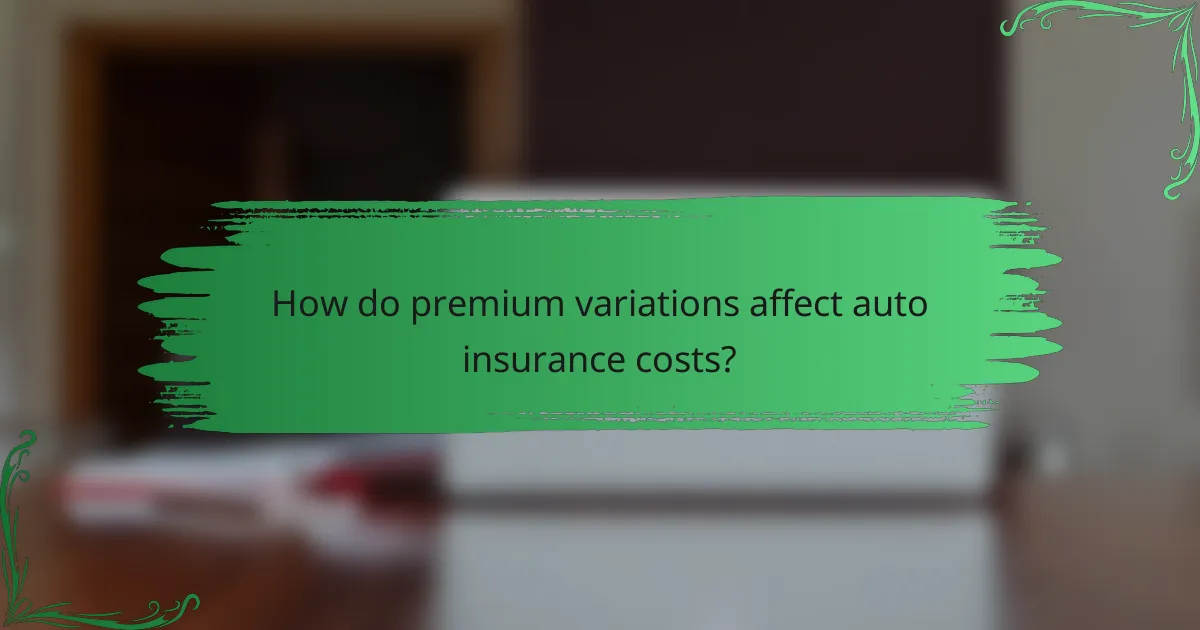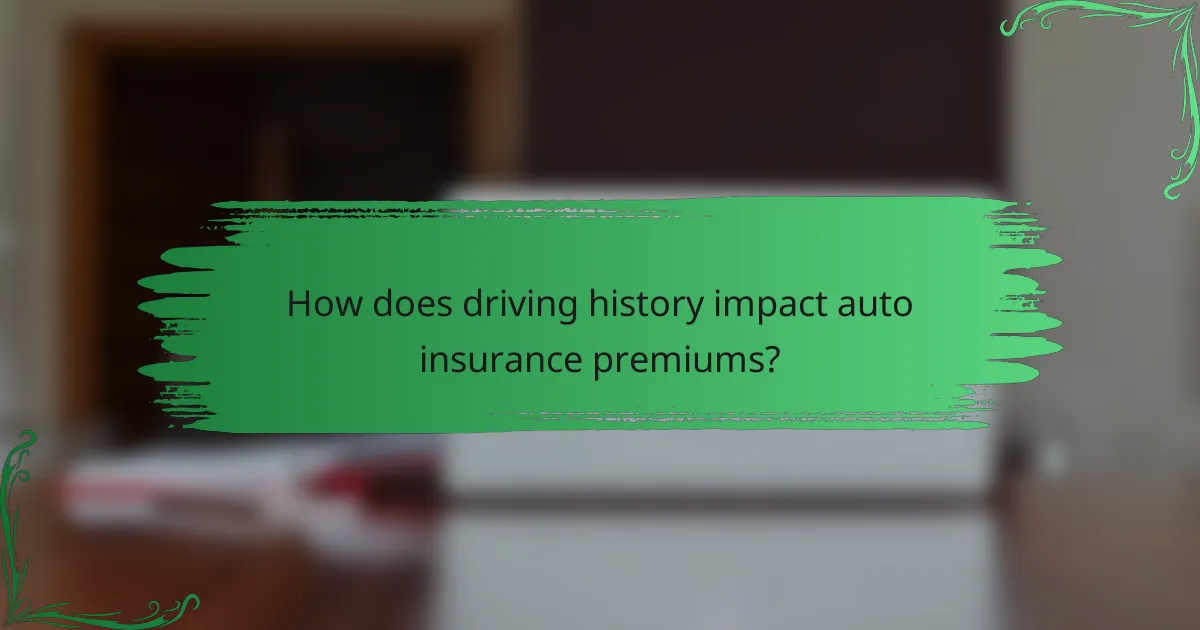Auto insurance in the UK comes in various types, each providing different levels of coverage and protection tailored to individual needs. Premiums can vary widely based on factors such as driving history, vehicle type, and selected coverage limits, impacting the overall cost of your policy. Understanding these elements is crucial for selecting the right insurance that fits both your requirements and budget.

What are the different types of auto insurance in the UK?
In the UK, there are several types of auto insurance, each offering varying levels of coverage and protection. Understanding these types can help drivers choose the right policy based on their needs and circumstances.
Third-party insurance
Third-party insurance is the minimum legal requirement for driving in the UK. It covers damages and injuries to other people and their property if you are at fault in an accident, but it does not cover your own vehicle or injuries.
This type of insurance is typically the most affordable option, making it suitable for drivers looking to meet legal obligations without extensive coverage. However, it leaves you financially vulnerable if you cause an accident resulting in damage to your own vehicle.
Third-party fire and theft
Third-party fire and theft insurance includes all the coverage of third-party insurance, plus protection for your vehicle against fire damage and theft. This makes it a more comprehensive option for those who want some level of protection for their own car.
While this type of policy is still generally lower in cost compared to comprehensive insurance, it is important to consider the value of your vehicle and the likelihood of theft in your area when choosing this coverage.
Comprehensive insurance
Comprehensive insurance provides the highest level of coverage, protecting against damage to your own vehicle as well as third-party claims. This includes coverage for accidents, theft, vandalism, and fire, regardless of who is at fault.
Although comprehensive policies tend to be more expensive, they offer peace of mind and financial security. Drivers with newer or more valuable cars often opt for this type of insurance to ensure they are fully protected.
Usage-based insurance
Usage-based insurance, also known as pay-as-you-drive insurance, adjusts premiums based on your driving habits. Insurers monitor factors such as mileage, speed, and braking patterns to determine your risk level and set your premium accordingly.
This type of insurance can be beneficial for low-mileage drivers who may save money compared to traditional policies. However, it requires a telematics device or app, which some drivers may find intrusive.
Classic car insurance
Classic car insurance is designed specifically for vehicles that are considered classic or vintage, typically over 15 years old. These policies often include specialized coverage options that account for the unique value and usage of classic cars.
When selecting classic car insurance, it is essential to provide accurate information about the vehicle’s condition, value, and intended use. Insurers may offer lower premiums for cars that are not used for daily driving, as this reduces the risk of accidents.

How do premium variations affect auto insurance costs?
Premium variations can significantly influence the overall cost of auto insurance. Factors such as driving history, vehicle type, and coverage limits all contribute to how much you pay for your policy.
Factors influencing premium variations
Several factors can lead to variations in auto insurance premiums. Key elements include your driving record, age, location, and credit score. For instance, drivers with a history of accidents or traffic violations typically face higher premiums compared to those with clean records.
Additionally, where you live can impact your rates. Urban areas with higher traffic congestion and crime rates often result in increased premiums, while rural locations may offer lower rates due to reduced risk.
Impact of vehicle type on premiums
The type of vehicle you drive plays a crucial role in determining your insurance premium. Generally, high-performance cars or luxury vehicles tend to have higher premiums due to their increased repair costs and higher likelihood of theft. Conversely, more economical and safer vehicles usually attract lower premiums.
Insurance companies often assess the vehicle’s safety ratings and repair costs when calculating premiums. For example, a family sedan with good safety ratings may cost less to insure than a sports car with a higher risk profile.
Role of coverage limits in premium costs
Coverage limits directly affect your auto insurance premium. Higher coverage limits typically lead to increased premiums, as they represent greater potential payouts for the insurer. It’s essential to balance adequate coverage with affordability.
For instance, if you choose minimum liability coverage, your premiums may be lower, but you could face significant out-of-pocket expenses in the event of an accident. Evaluating your financial situation and potential risks can help you select appropriate coverage limits that suit your needs.

What are the coverage limits for different auto insurance types?
Coverage limits for auto insurance types vary significantly based on the policy selected, the insurer, and local regulations. Understanding these limits helps drivers choose the right coverage for their needs and budget.
Minimum coverage requirements in the UK
In the UK, the minimum legal requirement for car insurance is third-party coverage, which protects against damage to other vehicles and injuries to other people. The minimum coverage limits are not specified in monetary terms, but drivers must have sufficient coverage to meet potential claims from third parties.
While third-party insurance is the bare minimum, many drivers opt for more comprehensive policies that include additional protections, such as fire and theft, to better safeguard their own vehicles.
Typical coverage limits for comprehensive insurance
Comprehensive insurance typically offers higher coverage limits than minimum requirements, often covering the full value of the insured vehicle. Many policies provide limits ranging from £20,000 to £50,000 or more, depending on the vehicle’s worth and the insurer’s terms.
In addition to vehicle damage, comprehensive policies usually cover personal injury, theft, and damage caused by natural disasters, providing a broader safety net for drivers.
Variations in coverage limits by provider
Coverage limits can vary widely among different insurance providers, with some offering customizable options that allow policyholders to adjust their limits based on personal needs. It’s common for insurers to provide basic, standard, and premium packages, each with different coverage levels.
When comparing providers, consider not only the coverage limits but also the deductibles and additional benefits included in each policy. This ensures you choose a plan that offers the best protection for your situation without overspending.

How does driving history impact auto insurance premiums?
Your driving history significantly influences your auto insurance premiums. Insurers assess factors like claims history, traffic violations, and driving experience to determine the risk you pose as a driver, which in turn affects your rates.
Effect of claims history on premiums
A history of claims can lead to higher premiums because insurers view frequent claims as a sign of riskier behavior. If you have made multiple claims in the past few years, you might see your rates increase by a substantial percentage, often ranging from 20% to 50% depending on the insurer.
To mitigate this impact, consider maintaining a clean claims record. If you can afford to pay for minor damages out of pocket, it may help keep your premiums lower in the long run.
Impact of traffic violations on insurance costs
Traffic violations, such as speeding tickets or DUIs, can significantly raise your auto insurance costs. A single violation can increase your premium by approximately 10% to 30%, while more severe offenses like DUIs may lead to even higher increases or the inability to obtain certain policies.
To avoid these penalties, practice safe driving habits and consider attending defensive driving courses, which may help reduce points on your license and, in some cases, lower your insurance rates.
Role of driving experience in premium calculations
Driving experience is a crucial factor in determining auto insurance premiums. Generally, newer drivers or those with less experience are considered higher risk, resulting in higher premiums. For instance, young drivers under 25 often face rates that are significantly higher than those for more experienced drivers.
To potentially lower your premiums, gain experience safely and consider enrolling in driver education programs. Some insurers offer discounts for completing these programs, which can help offset the costs associated with being a less experienced driver.

What criteria should you consider when choosing auto insurance?
When selecting auto insurance, consider coverage needs, premium costs, and customer service ratings. These factors will significantly influence your overall satisfaction and financial protection.
Assessing coverage needs
Start by evaluating the types of coverage you require, such as liability, collision, and comprehensive insurance. Each type serves a different purpose; for instance, liability covers damages to others, while comprehensive protects against non-collision incidents.
Consider your vehicle’s value and your driving habits. If you drive an older car, you might opt for lower coverage limits, whereas a new vehicle may warrant full coverage. Assessing your personal circumstances will help you determine the right balance between cost and protection.
Comparing premium costs
Premium costs can vary widely based on factors like your location, driving history, and the type of vehicle you own. It’s essential to obtain quotes from multiple insurers to find competitive rates that fit your budget.
Look for discounts that may apply to you, such as safe driver discounts or bundling policies. A good rule of thumb is to compare at least three to five quotes to ensure you are getting the best deal available.
Evaluating customer service ratings
Customer service ratings are crucial when choosing an auto insurance provider. High ratings indicate that the company is responsive and helpful in handling claims and inquiries.
Research reviews and ratings from independent sources to gauge customer satisfaction. Pay attention to how quickly claims are processed and the overall experience of other policyholders, as this can significantly impact your experience in the event of an accident.

What are the emerging trends in auto insurance in the UK?
Emerging trends in auto insurance in the UK include the rise of usage-based insurance, increased emphasis on digital services, and a growing focus on sustainability. These trends reflect changing consumer preferences and advancements in technology, impacting how policies are structured and priced.
Premium variations
Premium variations in auto insurance are influenced by factors such as driving history, vehicle type, and location. Insurers assess risk differently, leading to a range of premiums even for similar coverage. For example, drivers with a clean record may pay significantly less than those with multiple claims or traffic violations.
Additionally, the type of vehicle plays a crucial role. High-performance cars typically attract higher premiums due to their increased risk of accidents. Conversely, eco-friendly vehicles may benefit from discounts as insurers recognize their lower environmental impact.
Coverage limits
Coverage limits define the maximum amount an insurer will pay for a claim, and they can vary widely between policies. In the UK, standard coverage typically includes third-party liability, but many drivers opt for comprehensive coverage, which also protects against theft and damage to their own vehicle.
When selecting coverage limits, consider your vehicle’s value and your financial situation. For instance, if your car is worth a few thousand pounds, a high comprehensive limit may not be necessary. Always review your policy to ensure it meets your needs without overpaying.
Driving history impact
Your driving history significantly impacts your auto insurance premiums. Insurers use past behavior to predict future risk, meaning a history of accidents or violations can lead to higher rates. Conversely, a clean driving record can qualify you for discounts and lower premiums.
To maintain a favorable driving history, practice safe driving habits and consider taking advanced driving courses, which may also lead to premium reductions. Regularly review your insurance policy to ensure you are receiving appropriate discounts based on your driving record.



